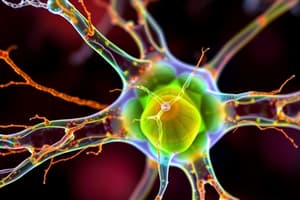Podcast
Questions and Answers
Which type of cytoskeletal element is primarily responsible for providing structural support during cell division and contributes to the shape of the cell?
Which type of cytoskeletal element is primarily responsible for providing structural support during cell division and contributes to the shape of the cell?
- Microfilaments
- Nuclear lamina
- Microtubules (correct)
- Intermediate filaments
What role do intermediate filaments play in the cell nucleus?
What role do intermediate filaments play in the cell nucleus?
- Facilitate cytokinesis
- Form the nuclear lamina (correct)
- Provide tracks for organelles
- Aid in muscle contraction
Which protein is associated with the intermediate filaments found in epithelial cells?
Which protein is associated with the intermediate filaments found in epithelial cells?
- Desmin
- Neurofilament
- Vimentin
- Keratin (correct)
Which of the following statements about microfilaments is true?
Which of the following statements about microfilaments is true?
Which statement about the cytoskeleton is correct?
Which statement about the cytoskeleton is correct?
Flashcards are hidden until you start studying
Study Notes
Cytoskeleton Overview
- The cytoskeleton consists of microfilaments, microtubules, and intermediate filaments, play crucial roles in cellular structure and function.
- Water is the most abundant component in cells, followed by proteins.
- Structural proteins constitute the cytoskeleton, providing essential support and shape to the cell.
Functions of the Cytoskeleton
- Offers structural integrity to the cell and facilitates muscle contraction.
- Serves as a transport track for organelles within the cell.
- Involved in cytokinesis, which is the division of the cytoplasm during cell division.
- Plays a role in cell signaling and chromosome segregation.
- Acts as a template for constructing cell membranes, specifically referring to ectoplasm.
Intermediate Filaments
- Intermediate filaments are part of the cytoskeleton and are known for their strength, surpassing the strength of microfilaments.
- They contribute to the formation of the nuclear lamina, a dense fibrous network located inside the nucleus.
Types of Intermediate Filaments in Different Tissues
- Different tissues express various types of intermediate filaments:
- In muscle cells, desmin is the key intermediate filament protein.
- Epithelial cells contain keratin, essential for structural stability.
- Neurofilaments are present in neural cells, supporting their function.
- The nuclear envelope and nuclear lamina are also comprised of specific intermediate filaments tailored to tissue types.
Key Proteins
- Mention of specific proteins associated with distinct cell types highlights the versatility and specialization of intermediate filaments:
- In mesenchymal cells, a type of intermediate filament protein known as vimentin is found.
- In epithelial tissues, keratin serves as a crucial structural protein, while desmin is significant in muscle cells.
Studying That Suits You
Use AI to generate personalized quizzes and flashcards to suit your learning preferences.




